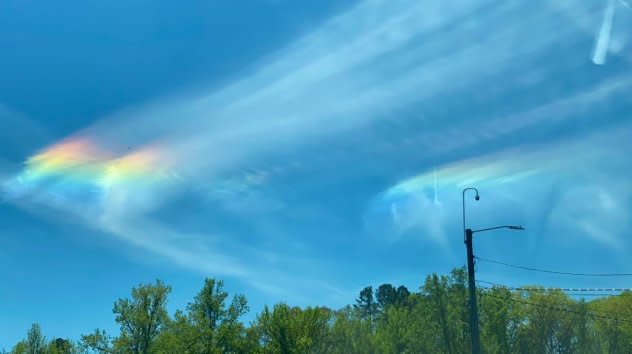'Fire rainbow' that enthralled Ohio residents wasn't really a rainbow at all
A video shared on social media showed what is known colloquially as a "fire rainbow" or sometimes "rainbow cloud" above Oak Harbor, Ohio, on April 25, 2024. The phenomenon is known technically as a "circumhorizontal arc" and is created by sunlight reflecting off of ice crystals.
A very delicate balance in the atmosphere is required for this effect to be achieved. To see this ice halo, the sun needs to be more than 58 degrees high in the sky, and high cirrus clouds or jet contrails must be present to bring this spectacular display to life. It's more typical only to see a piece of the colorful halo where the cloud is, as happened in Ohio.
The hexagonal, plate-shaped ice crystals inside the cirrus clouds also need to be aligned horizontally, so that the light entering through the vertical side of the crystals refracts, bends, and exits through the horizontal bottom. This disperses the light into the seven colors of the spectrum, similar to what we see in a rainbow.
Western North Carolina residents were also treated to a colorful atmospheric phenomenon on the afternoon of Good Friday, Apr. 15, 2022. Photos shared on social media showed what is known colloquially as a "fire rainbow" or, as people posting on Twitter referred to them, "rainbow clouds."
Brandon Carter, who captured one of the images, told AccuWeather, "I took the photo in Concord," a suburb of Charlotte that's just northeast of the city. He was driving when he spotted the dazzling spectacle in the sky.
 |
An optical phenomenon known as a 'circumhorizontal arc' treated people in North Carolina to an unusual sight in the skies on Friday, April 15, 2022. |
"When I saw it my first thought was to pull over and make sure my daughter could see what became known for the day as 'rainbow clouds,'" Carter, 41, who works in sales and said his true passion is astrophotography, recalled. "It was a great opportunity for my wife and I to talk to her about the science behind rainbows and a really cool moment."
Circumhorizontal arcs are not entirely rare in the skies over the United States but are more common in the tropics. However, they can not be seen in Arctic areas because the sun never appears high enough in the sky to allow for this delicate balance of ingredients to take place.


